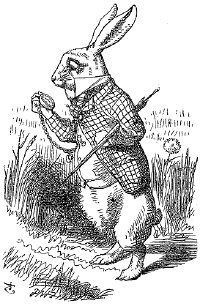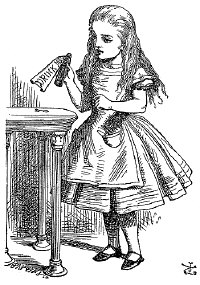Down the Rabbit Hole
Studies in Alice I, by Marc Edmund Jones
This lesson inaugurates the second half of the seventy-fourth year
in the presentation of the Sabian philosophy and begins a series of twenty-six
studies in a book that in barely more than a generation had become immortal
and is a consideration of the first chapter of Alice in Wonderland.
The lessons will deal in order with the twelve chapters of Wonderland,
the twelve chapters of Looking-Glass and two supernumerary studies.
The first great principle of wisdom in the Sabian philosophy as revealed
through the adventures of Alice is that everything in life is a sacrament.
In the field of philosophy the full power of idea in this concept of sacrament
is often unappreciated because of the association with ecclesiastical establishments,
but while a sacrament as the outward and visible sign of grace inwardly
received naturally would have a great deal to do with church ritual nevertheless
ritual is something larger than the observance of religious rites and a
sacrament therefore involves much more than the elements in the Eucharist.
The principle of life itself as a sacramental establishment was brought
out in the Ibn Gabirol lessons. There the student sees that all activity
of being is made possible by the interlocking ritual of the cosmos itself.
The whole substance of the Alice narratives is renewed demonstration. In
the lessons on Grimm's Fairy Tales the stories reveal the structure
of being and they unlock practically every mystery of the operation of
the soul, and this was discovered to be the direct result of the fact that
the stories were handed down through the human heart or were preserved
because they were loved and it is impossible to love except as ritual.
Nothing remains in human memory without some tie to experience, and the
race cannot hold or hand down ideas that are not enough in tune with the
eternal structure to become part of racial experience. So it is that some
stories die and others live and the same principle operates in every department
of life. In the lessons on the 1001 Nights, because of the extreme tenacity
with which these stories remained in the Near East consciousness, it became
possible to extract from them the complete and perfect psychology that
as the basis of the Sabian applied system has demonstrated itself with
almost infallible accuracy. The adventures of Alice would recommend themselves
by the mere virtue of their survival alone but there are added considerations
that give them unique value in the field of philosophy.
Of principal importance is the fact that they were written by a mathematician. Mathematics is a divine science not because of its abstractions but because of what its study does to the consciousness. An untutored individual turning to nonsense produces non-sense. Even Lewis Carroll himself when building on a conscious working at nonsense produced the relatively infantile Hunting of the Snark. But the so-called nonsense allowed to emanate spontaneously from a brain that has grooved itself in accordance with cosmic ritual almost infallibly will bring forth something of cosmic significance. This alone carried to its logical conclusion is the explanation of all inspiration whether through alcohol or more constructive agency. It is not coincidence that the wholly explicable working of the cosmic ritual creates such wonderland as this present study. There are occult factors such as the circumstance that Lewis Carroll wrote the book and not some other mathematician, but the explanation rather than being different is simply more detailed. Here for instance is the item of occult catalysis or coincidence of inspiration in the fact that the eldest Liddell child is named Alice, a Greek word meaning truth, because the bearing of the name by the youngster indicates to the occult student the outer indication of her possession of these catalytic qualities.
 The first chapter
reveals the sacramental factor pictured by the bottle of liquid or the
element of wine with description of its flavor and the little cake or the
element of bread. The drink-me and eat-me of the labels represent the idea
of compulsion in cosmic process or the first law of abstract being as persistency
in being. The drinking, or wine as blood or consciousness or spirit, is
the compulsion of spirit's descent into matter dramatized in growing smaller
and smaller whereas the eating or metabolism through which matter is forced
to be ensouled progressively by higher and higher forms of life is the
compulsion of matter's ascent into full participation in spirit as dramatized
by growing higher and higher. These details are too perfect for a cry of
coincidence and continue to bear weight forever. Such is the wolf! wolf!
of the materialists.
The first chapter
reveals the sacramental factor pictured by the bottle of liquid or the
element of wine with description of its flavor and the little cake or the
element of bread. The drink-me and eat-me of the labels represent the idea
of compulsion in cosmic process or the first law of abstract being as persistency
in being. The drinking, or wine as blood or consciousness or spirit, is
the compulsion of spirit's descent into matter dramatized in growing smaller
and smaller whereas the eating or metabolism through which matter is forced
to be ensouled progressively by higher and higher forms of life is the
compulsion of matter's ascent into full participation in spirit as dramatized
by growing higher and higher. These details are too perfect for a cry of
coincidence and continue to bear weight forever. Such is the wolf! wolf!
of the materialists.
The achievement of imagination in the book, or the first great scientific anticipation, is in the proper employment of symbolism. The function of symbols is to give form to spiritual concept. Whatever serves as symbol is not itself the symbol but rather the symbol is idea to which the form gives substance in addition to giving substance to its own being. Carroll here unwittingly anticipated the dictum recently popularized by modern science as anything that man imagines he may achieve. This is quoted from the Latin by Montaigne as a saying of the wise and so is far from modern. Everything goes back to consciousness as it is taught in the Sabian work, or interest as conventional psychology and science state it, and the positive basis of all interest is living activity. Thus Alice didn't like the book there by the river's bank on the July afternoon because it didn't have conversations or illustrations. Modern editorial policy well recognizes this in its demand for dialogue and illustrations and it is curious here to note that the coincident genius of John Tenniel has survived the growth of a whole new technique of illustrative art. Actually, the book is incomplete without his incomparable woodcuts. The negative basis of interest is its need to stamp itself in life or to express itself. Thus Alice in falling had to talk. Similarly every person or group of people has to talk, and the wisdom and lack of wisdom in giving or withholding free speech is here seen. It is necessary to link this expression and interest to the known, and it is illuminating to see Alice constantly using Dinah as the subject of conversation.
 The law of
applied psychology or the first big idea for the solution of personal problems
is brought out here in the technique of action in falling or failure. The
student must come to learn relativity in any state of consciousness. There
is said to be special providence for drunks and fools and this is no more
than the fact that the drunk or fool refuses to allow outer reality to
upset the inner sense of reality. He can almost fall down a hole literally
and escape injury. Everything is relative and thus it is that Alice while
falling finds the jar of marmalade empty whereas later the bottle and glass
box are not. Under most circumstances the attempts to salvage wreckage
in life are empty and fruitless. The student must learn to UNCLUTCH
AND LET GO. When Alice went to sleep she found bottom, unhurt. Relaxation
is the key to the foundation of all constructive effort.
The law of
applied psychology or the first big idea for the solution of personal problems
is brought out here in the technique of action in falling or failure. The
student must come to learn relativity in any state of consciousness. There
is said to be special providence for drunks and fools and this is no more
than the fact that the drunk or fool refuses to allow outer reality to
upset the inner sense of reality. He can almost fall down a hole literally
and escape injury. Everything is relative and thus it is that Alice while
falling finds the jar of marmalade empty whereas later the bottle and glass
box are not. Under most circumstances the attempts to salvage wreckage
in life are empty and fruitless. The student must learn to UNCLUTCH
AND LET GO. When Alice went to sleep she found bottom, unhurt. Relaxation
is the key to the foundation of all constructive effort.

Sabian.org





